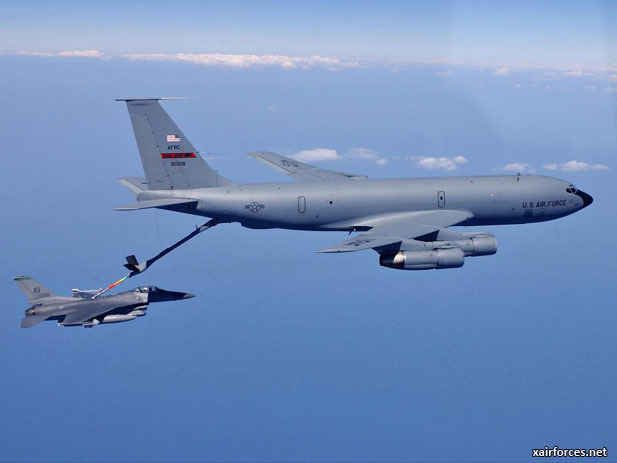
Edwards Completes Tests To Extend KC-135

Block 45 Upgrades Will Extend Airplanes Life 'For Decades' Known as "The Mighty War Wagon" of the Air Force, the KC-135 Stratotanker has proven to be the core aerial refueling capability for the Air Force for more than 50 years.
With the help of the 418th Flight Test Squadron at Edwards, along with a multitude of testers, the KC-135 Block 45 test team recently completed a series of tests in April to help extend the aircraft's service life for decades.
"There are currently 419 KC-135s and 59 KC-10s that enhance the Air Force's capability to accomplish its primary mission of Global Reach while providing aerial refueling support to Air Force, Navy, Marine Corps and allied nation aircraft. These aircraft also provide mission support including cargo, aeromedical evacuation, personnel transport, and a variety of other specialized missions," said Maj. John Mikal, 418th FLTS KC-135 Block 45 lead project test pilot. "Increasing the life expectancy of the current Air Force tanker fleet is critical. Ongoing upgrade programs help to ensure there is no gap in these mission capabilities, while the new KC-46 program starts replacing the aging KC-135 fleet."
As part of the KC-135 Block 45 upgrades, Mikal said they included a digital flight director, a radar altimeter, an electronic engine instrument display, and Automatic Flight Control System or Autopilot for Communications, Navigation, Surveillance/Air Traffic Management (CNS/ATM) requirements in order to maintain global airspace access. "Maintenance sustainability was another item that was looked at, which addresses the need to deal with parts that are obsolete, since no one makes the old parts anymore," said Mikal.
"Commercial off-the-shelf equipment or systems will be used to replace the existing analog flight director, radio altimeter, autopilot, and 21 cockpit engine instruments with newer digital technology equipment that will be integrated into the existing avionics."
According to Mikal, the new upgrades will ensure:
- The extension and improvement of mission capability and sustainability of the KC-135 fleet
- The new digital avionics technology integrated into the legacy system will increase safety, efficiency and reliability
- Effective replacement of obsolete components
- The KC-135 meets current and future CNS/ATM requirements, allowing unrestricted operations in commercial and military airspace throughout the world.
At the initial start of the KC-135 Block 45 program, it was originally estimated that testing would end in March 2011, but the technical challenge of integrating the new digital systems proved to be very challenging, according to the test team. "It took an amazing amount of ingenuity and hard work by the collective KC-135 Block 45 upgrade team, due to the program experiencing a two-month stop in test in early 2012 to determine the cause of a structural coupling event which occurred during flight test," Mikal said. "While clearing the aerial refueling envelope, the performance of the new autopilot altitude hold was so good, re-adjustment was required to improve stability during aerial refueling coupled flight."
Along with the 418th, the massive, multi-year undertaking required support from more than 90 members to overcome technical hurdles and prevent the very real threat of program cancellation. Of those included, individuals were acquired from the 412th Test Wing, 412th Operations Group, 412th Test and Engineering Group, 773rd Test Squadron, 775th Test Squadron, 370th Flight Test Squadron, 445th Flight Test Squadron, the KC-135 Special Programs Office, Rockwell Collins, Air Mobility Command Test and Evaluation Squadron Detachment 3, AMC Air, Space and Information Operations (A3), and McConnell Air Force Base, KS.
The Air Force says that the first 18 of the new KC-46 tankers are expected to have been delivered by 2017 .
Source: www.af.mil News - 28 April 2013
Photo: The U.S. Air Force KC-135 Block 45 Aircraft (Photo by USAF)
(28.04.2013)
|